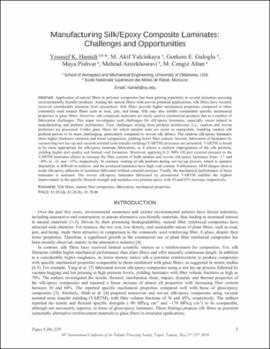| dc.creator | Hamidi, Youssef K. | |
| dc.creator | Yalcinkaya, M. Akif | |
| dc.creator | Guloglu, Gorkem E. | |
| dc.creator | Pishvar, Maya | |
| dc.creator | Amirkhosravi, Mehrad | |
| dc.creator | Altan, M. Cengiz | |
| dc.date.accessioned | 2018-04-19T21:05:02Z | |
| dc.date.available | 2018-04-19T21:05:02Z | |
| dc.date.issued | 2018-05-21 | |
| dc.identifier.citation | Y. K. Hamidi, M. A. Yalcinkaya, G. E. Guloglu, M. Pishvar, M. Amirkhosravi and M. C. Altan, "Manufacturing Silk/Epoxy Composite Laminates: Challenges and Opportunities," Proceedings of the Polymer Processing Society, PPS-34, 2018. | en_US |
| dc.identifier.uri | https://hdl.handle.net/11244/299449 | |
| dc.description | Presented at the 34th International Conference of the Polymer Processing Society, May 24, 2018. | en_US |
| dc.description.abstract | Application of natural fibers in polymer composites has been gaining popularity in several industries pursuing
environmentally friendly products. Among the natural fibers with proven potential applications, silk fibers have recently
received considerable attention from researchers. Silk fibers provide higher mechanical properties compared to other
commonly used natural fibers such as sisal, jute, and hemp. Silk may also exhibit comparable specific mechanical
properties to glass fibers. However, silk composite laminates are rarely used in commercial products due to a number of
fabrication challenges. This paper investigates such challenges for silk/epoxy laminates, especially issues related to
manufacturing and preform architecture. First, challenges arising from preform architecture (i.e., random and woven
preforms) are presented. Unlike glass fibers for which random mats are easier to manipulate, handling random silk
preform proves to be more challenging, particularly compared to woven silk fabrics. The random silk/epoxy laminates
show higher thickness variation and lower compaction, yielding lower fiber content. Second, fabrication of laminates by
vacuum bag/wet lay-up and vacuum assisted resin transfer molding (VARTM) processes are presented. VARTM is found
to be more appropriate for silk/epoxy laminate fabrication, as it allows a uniform impregnation of the silk preform,
yielding higher part quality and limited void formation. Moreover, applying 0.21 MPa (30 psi) external pressure to the
VARTM laminates allows to increase the fiber content of both random and woven silk/epoxy laminates from ~17 and
~30% to ~21 and ~33%, respectively. In contrast, wetting of silk preform during wet lay-up process, which is operator
dependent, is difficult to achieve; and the produced laminates have high void content. Furthermore, SEM images show a
weak silk/epoxy adhesion in laminates fabricated without external pressure. Finally, the mechanical performance of these
laminates is assessed. The woven silk/epoxy laminates fabricated by pressurized VARTM exhibits the highest
improvement in the specific flexural strength and modulus over pristine epoxy with 30 and 65% increase, respectively. | en_US |
| dc.format.medium | application.pdf | en_US |
| dc.language | en_US | en_US |
| dc.relation.requires | Adobe Acrobat Reader | en_US |
| dc.subject.lcsh | Laminated materials | en_US |
| dc.subject.lcsh | Epoxy resins | en_US |
| dc.subject.lcsh | Silk | en_US |
| dc.title | Manufacturing silk/epoxy composite laminates : challenges and opportunities | en_US |
| dc.type | Article | en_US |
| dc.description.peerreview | Yes | en_US |
| dc.description.peerreviewnotes | Peer reviewed for the Proceedings of the 34th International Conference of the Polymer Processing Society, Taipei, Taiwan, May 21st-25th 2018. | en_US |
| ou.group | College of Engineering::School of Aerospace and Mechanical Engineering | en_US |
| dc.type.material | text | en_US |
| dc.subject.keywords | Silk-epoxy laminates | en_US |
